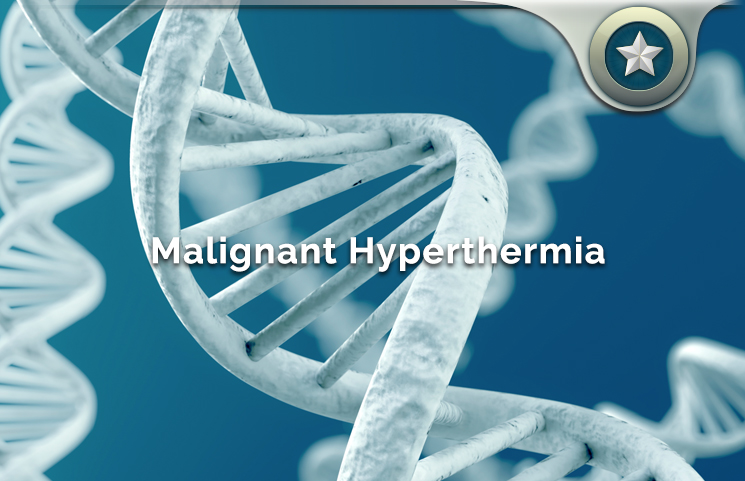Malignant hyperthermia is a clinical syndrome of hyper-metabolism that involves the skeletal muscles. The disease is triggered in susceptible individuals by the inhalation of volatile anesthetic agents.
Succinylcholine, which is a muscle relaxant, is also a trigger factor of malignant hyperthermia. Other drugs can also cause malignant hyperthermia to occur. Contrary to most people’s beliefs, malignant hyperthermia is not an allergic reaction.
It is a form of an inherited disorder that is found in both humans and swine. Individuals who are susceptible to malignant hyperthermia have an abnormal ryanodine receptor in the skeletal muscles.
The abnormality in the ryanodine receptor alters the regulation of calcium in the skeletal muscles. As a result, there is a buildup of calcium in the skeletal muscles, leading to a high metabolic reaction.
The increase in the metabolic reaction results in an increase in the production of carbon dioxide. There is also an increase in metabolic and respiratory acidosis, production of heat, increased consumption of oxygen, and activation of the sympathetic nervous system. The patient may also experience a multiple organ dysfunction or even organ failure.
The triggering of malignant hyperthermia by anesthetic agents is not consistent. An individual who is vulnerable to malignant hyperthermia can undergo anesthesia with malignant hyperthermia triggering agents without developing any incident. However, they may react to the triggering anesthetic agents on a subsequent treatment.
Malignant Hyperthermia Symptoms And Risk Factors
Early clinical signs of malignant hyperthermia include a rise in end-tidal carbon dioxide. The patient may also present with tachycardia, hyperkalemia, and muscle rigidity.
There is a sudden increase in body temperature that may elevate to 113 degrees Fahrenheit. The muscle rigidity may present with pain, especially in the jaw. There are also respiratory disturbances, such as rapid breathing or uncomfortable breathing.
Symptoms of malignant hyperthermia result about one hour after the administration of the trigger medication. Most cases of the disease are observed in children and adults that are younger than 30 years. Malignant hyperthermia is caused by a mutation that occurs in the presence of abnormal proteins in the skeletal muscles.
Individuals who are susceptible to malignant hyperthermia are normal in everyday life. However, when they are exposed to the trigger factors of malignant hyperthermia, they develop the clinical signs.
The risk factors for malignant hyperthermia include exposure to anesthetic agents, exposure to high environmental heat, or strenuous exercise. The exposure to these risk factors causes an abnormal release of calcium from its storage site in the muscle cells. As a result, the patient experiences a sustained muscle contraction that leads to an abnormal hypermetabolism and heat production.
The process depletes the muscle of adenosine triphosphate, which is the source of cellular energy in the body. The depletion of adenosine triphosphate leads to cell death and as a result, there is an increase in the release of potassium into the bloodstream causing hyperkalemia. The increase in the potassium levels in the blood stream is then followed by a rise in heart rate. The patient may experience cardiac arrhythmias.
The abnormal release of calcium from the sarcoplasmic reticulum also causes the release of the muscle pigment known as myoglobin. Myoglobin has toxic effects on the kidney when it is released.
If these occurrences are left untreated, the patient can develop kidney failure, cardiovascular problems, brain injury, internal hemorrhage, or liver failure. Besides the anesthetic agent, studies suggest that other causes of muscle breakdown can be a risk factor for malignant hyperthermia.
According to studies, individuals who develop muscle breakdown after an exercise activity or heat stroke may also harbor the genetic factors that are linked to malignant hyperthermia. However, it is not clear if the non-anesthetic agents actually cause the muscle breakdown.

Diagnosis Of Malignant Hyperthermia
Because malignant hyperthermia is an inherited disorder, members of a family in which malignant hyperthermia has been identified are also considered susceptible. The disease is often discovered after a patient has been administered an anesthetic agent during a surgical procedure.
The patient will present with early clinical signs, including a fast and often irregular heart rhythm. Tests for malignant hyperthermia may include blood clotting studies.
Under these tests are the prothrombin time and the partial thromboplastin time. A blood chemistry panel, which includes creatinine phosphokinase, may also be performed. Creatinine phosphokinase may increase after a muscle breakdown.
Genetic testing may also be conducted to find out any defects in the genes that may cause malignant hyperthermia. Other tests that may be performed include muscle biopsies and urology tests.
Malignant Hyperthermia Prevention
It is not possible to test malignant hyperthermia in every patient that is scheduled for a surgical procedure. However, it is advisable to check some people before they undergo surgery, especially those that carry risk factors.
Susceptible individuals should avoid anesthetics that are known to cause malignant hyperthermia. Vulnerable individuals include members of a family in which the disorder has already been diagnosed, people who experience heat stroke or hyperthermia after an exercise activity, and/or patients who have muscle abnormalities that may be linked to malignant hyperthermia.
The first episode of an individual that does not have a family history of the disorder cannot be prevented or predicted. However, once the patient has been diagnosed with the disorder, subsequent episodes can be avoided.
It is advisable to notify your healthcare administer before undergoing a surgical procedure. Prior notification will enable the doctor or dentist to avoid the use of succinylcholine or other high-risk anesthetic agents. One does not have to avoid surgery completely. There are several safe alternative anesthetic agents. Individuals who are susceptible to malignant hyperthermia should consider putting on a medical alert tag.
The tag will caution the doctor during an emergency treatment. Individuals who are planning on traveling outside The United States should consider contacting the Malignant Hyperthermia Association of the United States before traveling.
The association will help determine whether the doctors at your travel destination have knowledge on malignant hyperthermia and how to manage the disorder and educate medical staff in the case of a medical emergency.
It is an important precaution because malignant hyperthermia is a rare condition.
Malignant Hyperthermia Treatment
Doctors should treat malignant hyperthermia as soon as they suspect it in a patient. The most important step in the treatment of the disorder is to cease the administration of the triggering anesthetic agent.
Doctors then administer a drug known as dantrolene to the patient. Indications for treatment of the disorder with dantrolene include the presence of tachycardia, muscle rigidity, and clinical signs of hypermetabolism. However, not all these symptoms are present in all individuals that are diagnosed with malignant hyperthermia.
Dantrolene should be administered immediately if an acute malignant hyperthermia reaction is observed in the patient. Waiting for too long before initiating the therapy can lower the chances of recovering completely.
When a malignant hyperthermia reaction is detected, it is advisable to refer the patient to a malignant hyperthermia biopsy testing center as well. When a rapidly progressive malignant hyperthermia is suspected, the patient should be put on rapid administration of dantrolene. The doctor should also discontinue the use of triggering anesthetic agents immediately.
Management of rapidly progressing malignant hyperthermia may also require assistance from extra medical personnel. An early treatment of hyperkalemia is recommended. Calcium-channel blockers should not be administered together with dantrolene.
The activity of these two drugs may result in hyperkalemia. The healthcare provider should have a malignant hyperthermia cart or tote containing dantrolene together with other necessary supplies that are needed to reverse the disorder immediately.
The recommended dose of dantrolene is 36 vials with a concentration of 2.5mg/vial. The MH tote should be available whenever a surgical procedure is being performed.
Dantrolene is a hydantoin derivative. The mechanism action of this drug involves directly interfering with the process of muscle contraction by preventing the release of calcium ions from sarcoplasm reticulum. The drug then acts by binding to ryanodine receptor type 1. Its initial dose is 2.5mg/kg. The dose is administered every five minutes until reversal of the malignant hyperthermia reactions.
Some practitioners stop dantrolene administration when total dose of 20 mg/kg is attained. If there is not any clinical improvement, a different diagnosis should be performed. Dantrolene also works by reducing the high body temperature in other disorders besides malignant hyperthermia, such as neuroleptic malignant syndrome, sepsis, and thyroid syndrome.
After the initial reaction of the disorder is controlled, the patient should be put under continuous monitoring for 24-48 hours in the intensive care unit. Dantrolene should then be administered every 4-6 hours. The patient should be monitored for myoglobinuria, and if present, it should be treated with fluids and diuretic agents.
There is a new version of dantrolene, which is absorbed into a solution within 15 seconds. The new version also has a fast onset of action with charcoal filters that can be placed in the anesthesia machine circuit. The filters remove the anesthetic agent in about two minutes, and it helps reverse malignant hyperthermia reaction quickly.

When To Call A Doctor
Before undergoing surgery, you should inform the doctor if you have a family member that has malignant hyperthermia. Alert the doctor if you have experienced one or more episodes of exercise-induced hyperthermia or heat stroke. You should also inform the doctor if you have any known muscle diseases.
Malignant Hyperthermia Conclusion
An episode of malignant hyperthermia can be life-threatening. However, an early therapy at the onset of symptoms can be successful.
Once the disorder has been recognized and diagnosed, future episodes can be prevented.









